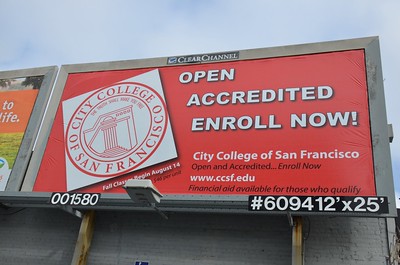If you want to get a decent idea of the future that could await US community colleges, take a look at City College of San Francisco. For the last dozen years, CCSF has struggled with problems ranging from finances and administration to operations and oversight.
CCSF is probably the poster child for mismanagement, and although CCSF’s current books don’t show it, a new financial storm is brewing for what was once one of the largest community colleges in the United States.
In 2011, its enrollment peaked at more than 95,000 students. Today, its enrollment is about 40% of that. But at the time its classrooms were filled, CCSF’s accreditors, the Accrediting Commission for Community and Junior Colleges (ACCJC) of the Western Association of Schools and Colleges, sounded the alarm about a variety of problems including the annual turnover of the chancellor’s office (nine in eight years) and issues that led the college to the verge of bankruptcy. That also attracted the attention of the State of California, which sent in a fiscal crisis team to monitor CCSF’s books.
CCSF has a budget of $314M this year, which sounds absurdly luxurious for an institution with fewer than 40,000 students. (That’s about one-third more total revenue per student than WCC gets.) But CCSF has some unique challenges. However, California’s funding formula favors schools that serve traditional college students – the under 25 crowd. Like many community colleges, CCSF is rife with non-traditional students. The effect of this preference is that CCSF stands to lose about $35M in state funding starting next year. Under the current state funding strategy, the only way to avoid this is to recruit thousands of traditional college students, which seems painfully unlikely at the very best.
CCSF challenges will mount over time
The last time I wrote about CCSF, the college had announced faculty layoffs and course cancellations as its preferred strategy to balance the budget. (According to the institution’s current org chart, they have 10 vice chancellors of one stripe or another – still fewer than WCC.) The layoffs occurred, and the faculty union successfully pushed a slate of new trustees during the most recent election in November 2022.
In January 2023, four pro-faculty trustees joined the institution’s board. Their goal is to rehire the faculty who were laid off and build new courses – ostensibly to attract more students. The other trustees want to use the school’s remaining funds to shore up the school’s under-funded pension and increase its rainy-day fund. And the school’s current chancellor, Dr. David Martin, has informed the Board that he’s out at the end of the fiscal year.
Tuition at CCSF for city residents is $46 per credit hour, which is incredibly low and hasn’t changed in at least a decade. To replace the lost funding from the state, CCSF would have to triple the number of credit hours its students enroll in. Raising tuition is a hard sell because San Francisco is currently the sixth most expensive city in the United States. Each year, it becomes harder for low-income residents to remain in San Francisco – which partially explains CCSF’s declining enrollment.
There is a false dichotomy at work here. It is possible to both cut old programs and build new ones to attract more students. The school can simultaneously reduce expenses and prepare for future financial challenges. None of its challenges require a Boolean choice.
Want more students? Make attendance worthwhile
The only way to attract more students to any community college is to make it worth their while to attend classes. According to a recent study by SmartAsset, a person needs to make about $85,000 to live comfortably in San Francisco. According to MIT’s Living Wage Calculator, a single person with no dependents needs a minimum of $55,000 per year to live in San Francisco County (not necessarily in the City of San Francisco).
Currently, the median earnings of a CCSF student 10 years after first enrollment is $47,000. That’s too low to allow these students to earn a living wage in San Francisco. CCSF should immediately identify and promote high-wage, high-demand programs that can help students earn $60,000-$80,000 per year with a two year degree. Additionally, the college should plan to introduce 2-3 high wage programs over the next 2-3 years. At the same time, it should eliminate 3-5 programs each year that prepare students for low-wage jobs.
CCSF should begin to recruit traditional college students, starting when those students are in middle school. Additionally, it should develop a dual-enrollment program. Currently, CCSF enrolls only a small number of students under the age of 18. CCSF also has a graduation rate of just 28%. By improving student retention, it could make up some of the state revenue it will lose beginning in FY 2025.
CCSF (and every other community college) can work on multiple fronts to increase enrollment, improve graduation rates, and attract students by offering more high-wage, high demand programs and fewer low-wage ones. But it is an ongoing process whose ultimate goal has to be putting people in high wage jobs.
Photo Credit: Steve Rhodes , via Flickr




















